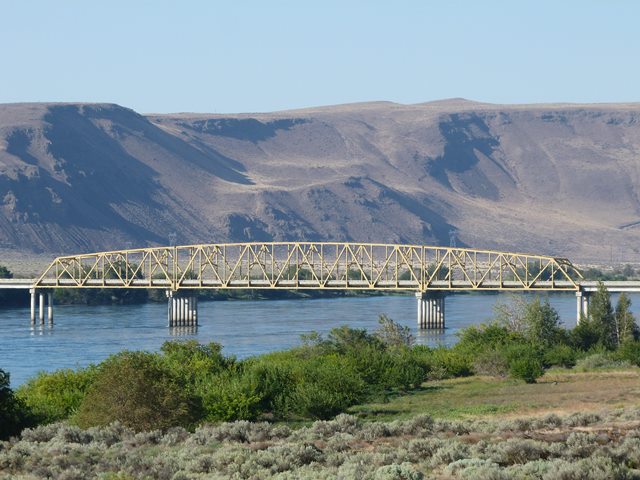We Recommend:
Bach Steel - Experts at historic truss bridge restoration.
Vernita Bridge

Primary Photographer(s): Nathan Holth
Bridge Documented: August 27, 2014
Rural: Benton County, Washington and Grant County, Washington: United States
Metal 10 Panel Rivet-Connected Polygonal Warren Through Truss, Fixed and Approach Spans: Pre-Stressed Concrete Stringer (Multi-Beam), Fixed
1965 By Builder/Contractor: Peter Kiewit and Sons of Omaha, Nebraska
Not Available or Not Applicable
264.0 Feet (80.5 Meters)
1,982.0 Feet (604.1 Meters)
28 Feet (8.53 Meters)
3 Main Span(s) and 14 Approach Span(s)
0007619A0000000

View Information About HSR Ratings
Bridge Documentation
View Archived National Bridge Inventory Report - Has Additional Details and Evaluation
View Historical Articles About This Bridge
This bridge is unusual because its three main spans have polygonal top chords that are oriented in a manner that the three spans form a single arch shape, making the bridge look like a single continuous three-span truss. However, in reality the trusses are three simple spans. Mark Bozanich commented on www.bridgehunter.com that the Vernita Bridge was built with three simple trusses so that the center truss could be converted to a vertical lift span. There were plans at one time to build a dam downstream from Vernita and upstream from the Tri-Cities equipped with locks. Plans were abandoned now that the dam site is part of the Hanford Reach National Monument. Mark's comments seem to be supported by the physical configuration of the truss. Most notably, the piers for the center truss span are quite a bit wider than they need to be, suggesting that the piers were built to either completely or partially accommodate the towers that would be needed to make the bridge a vertical lift. Also, at the pier, the vertical end posts have empty bolt holes which could have been intended for attaching the lift tower and related materials.
The bridge is a late example of a metal truss bridge, and barely old enough to be considered historic. However, the bridge does stand out for its unusual false-continuous design. It also represents the end of the riveted truss era. Truss bridges built in the 60s like this bridge usually have details that show the decline in use of rivets and increase in the use of welds and bolts. What is unusual is that this bridge still used riveted connections, instead of bolted connections which are often found on 1960s bridges. In contrast, the built-up beams that compose the truss are welded, which is unusual since the built-up beams is one location where rivets are often still found on 1960s bridges.
![]()
Photo Galleries and Videos: Vernita Bridge
Bridge Photo-Documentation
Original / Full Size PhotosA collection of overview and detail photos. This gallery offers photos in the highest available resolution and file size in a touch-friendly popup viewer.
Alternatively, Browse Without Using Viewer
![]()
Bridge Photo-Documentation
Mobile Optimized PhotosA collection of overview and detail photos. This gallery features data-friendly, fast-loading photos in a touch-friendly popup viewer.
Alternatively, Browse Without Using Viewer
![]()
Maps and Links: Vernita Bridge
Coordinates (Latitude, Longitude):
Search For Additional Bridge Listings:
Bridgehunter.com: View listed bridges within 0.5 miles (0.8 kilometers) of this bridge.
Bridgehunter.com: View listed bridges within 10 miles (16 kilometers) of this bridge.
Additional Maps:
Google Streetview (If Available)
GeoHack (Additional Links and Coordinates)
Apple Maps (Via DuckDuckGo Search)
Apple Maps (Apple devices only)
Android: Open Location In Your Map or GPS App
Flickr Gallery (Find Nearby Photos)
Wikimedia Commons (Find Nearby Photos)
Directions Via Sygic For Android
Directions Via Sygic For iOS and Android Dolphin Browser
USGS National Map (United States Only)
Historical USGS Topo Maps (United States Only)
Historic Aerials (United States Only)
CalTopo Maps (United States Only)

